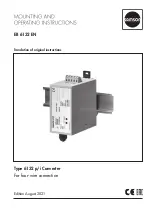
Introduction to the SCPI Language
SCPI Command Terminators
A command string sent to the instrument must terminate with a <new line> (<NL>) character. The IEEE-488 EOI
(End-Or-Identify) message is interpreted as a <NL> character and can be used to terminate a command string in place
of a <NL> character. A <carriage return> followed by a <NL> is also accepted. Command string termination will
always reset the current SCPI command path to the root level.
For every SCPI message that includes a query and is sent to the instrument, the instrument ter-
minates the returned response with a <NL> or line-feed character (EOI). For example, if
"DISP:TEXT?" is sent, the response is terminated with a <NL> after the string of data that is
returned. If a SCPI message includes multiple queries separated by semicolons (for example
"DISP?;DISP:TEXT?"), the returned response is again terminated by a <NL> after the response to
the last query. In either case, the program must read this <NL> in the response before another
command is sent to the instrument, or an error will occur.
IEEE-488.2 Common Commands
The IEEE-488.2 standard defines a set of common commands that perform functions such as reset, self-test, and
status operations. Common commands always begin with an asterisk (
*
), are three characters in length, and may
include one or more parameters. The command keyword is separated from the first parameter by a blank space. Use a
semicolon (
;
) to separate multiple commands as shown below:
*RST
;
*CLS
;
*ESE 32
;
*OPC?
SCPI Parameter Types
The SCPI language defines several data formats to be used in program messages and response messages.
Numeric Parameters
Commands that require numeric parameters will accept all commonly used decimal representations of numbers includ-
ing optional signs, decimal points, and scientific notation. Special values for numeric parameters such as MIN, MAX, and
DEF are also accepted. You can also send engineering unit suffixes with numeric parameters (e.g., M, k, m, or u). If a
command accepts only certain specific values, the instrument will automatically round the input numeric parameters
to the accepted values. The following command requires a numeric parameter for the frequency value:
[SOURce[1|2]:]FREQuency:CENTer {<
frequency
>|MINimum|MAXimum}
Because the SCPI parser is case-insensitive, there is some confusion over the letter "M" (or "m").
For your convenience, the instrument interprets "mV" (or "MV") as millivolts, but "MHZ" (or
"mhz") as megahertz. Likewise "MΩ" (or "mΩ") is interpreted as megohms. You can use the prefix
"MA" for mega. For example, "MAV" is interpreted as megavolts.
Discrete Parameters
Discrete parameters are used to program settings that have a limited number of values (like IMMediate, EXTernal, or
BUS). They may have a short form and a long form just like command keywords. You can mix upper- and lower-case
Agilent 33500 Series Operating and Service Guide
153
Содержание Agilent 33500 Series
Страница 1: ...Agilent Technologies 33500 Series Waveform Generator Operating and Service Guide ...
Страница 68: ...Output Configuration OUTPUT SYNC SOURCE CH1 CH2 Agilent 33500 Series Operating and Service Guide 67 ...
Страница 410: ...Block Diagram Block Diagram Agilent 33500 Series Operating and Service Guide 409 ...
Страница 429: ......
















































